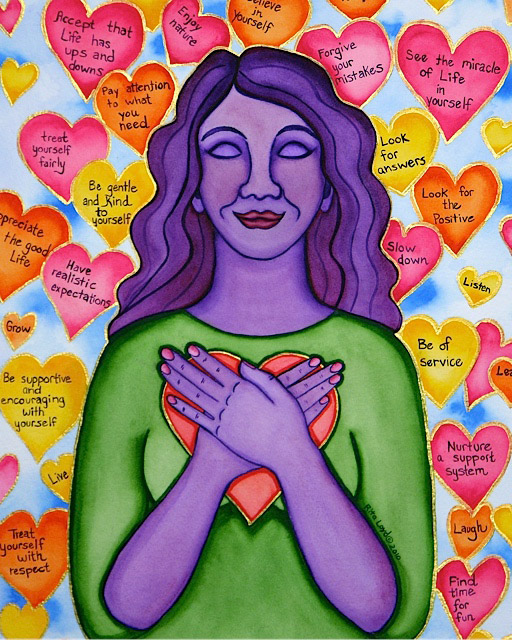
Letting go of ego and embracing spirit opens the doors to authentic self-love
—
I began painting healing art 20 years ago after the onset of chronic illness. When my health collapsed, so did my sense of self-love.
As a way to cope with my illness and depression, I decided to paint as a form of therapy. I wanted to create images that would uplift me. In order to do this, I first had to look at my life and see where my life needed lifting. That meant that I had to look at my pain and identify what was bothering me. Looking inward is not always easy, because it demands honesty — honesty about life and pain.
First, I had to create a safe space of observation before looking deep inside. I promised myself that I would look inward with only curiosity and neutrality. I was not allowed to be judgmental during this exercise because if I felt criticized during the process, I would become self-defensive and shut down.
Sometimes it’s not the problems in life that cause us to suffer the most; it’s the way we perceive them.
When we change our perspective, our suffering can diminish. So I would look at one problem in my life at a time. I would search my spiritual studies and my own thoughts for advice — and that advice is what I would paint.
An example of this process was when I was feeling worried about a situation that I had no control over. The advice that came into my mind was to go with the flow of life. So I painted myself as a peaceful body of water.
I continued to paint over the years until one day I made a life-changing discovery. I was drawing the image of a woman with words of encouragement surrounding her and then I realized that these words were messages of self-love. In fact, I could suddenly see that all of my paintings were messages of self-love. I thought I didn’t know what self-love was, so how could this be? I couldn’t see this before, because I was focused only on one problem and painting at a time. But after my epiphany ,I could see that each painting was a reflection of my journey in search of self-love.
Even more amazing was that I could see that my creative process was teaching me HOW to love myself by providing a setting and reason to:
– Slow down
– Look inward
– Ask myself questions
– Listen for answers
– Seek new solutions
– Be kind and patient with myself
– Trust in my instincts
– Encourage myself
– Embrace my sensitivity
– Forgive my mistakes
– Quiet my inner critic
– Give myself a voice in order to speak
Now that it was clear to me what self-love was — at least within the boundaries of creating my art — I felt motivated to do a personal study on self-love so I could incorporate this into the other areas of my life.
When I first got sick, I became physically weak, which caused me to lose my job and friends and to quit school. In return, my ego judged me as a failure and worthless because I could no longer do the things I used to do. My life had to look a certain way before my ego would allow me to love myself. Now that I could see this, I realized that my self-love had been conditional.
As I explored my thoughts about self-love and with the influence of Wayne Dyer’s book, Your Sacred Self: Making the Decision to be Free, which explains the difference between the spirit and ego, I came to the conclusion that there are two kinds of self-love: ego-based and spirit-based. The former cares about what the ego cares about — appearances, power, and survival — whereas the latter cares about what the spirit cares about — healing, wholeness, and compassion.
The reason why my self-love collapsed earlier in my life was that it came from my ego rather than my spirit.
Knowing this gave me the freedom to choose a different kind of self-love.
Before I found authentic self-love, I would confuse the idea with the act of pampering myself: buying a new outfit, getting a manicure, or going on vacation. Pampering is not a bad thing if you can afford it, but it does become self-sabotage if you can’t. Pampering is more about distracting us from our problems rather than dealing with our problems in order to solve or manage them.
Real self-love is not about anything you can buy. Real self-love is about examining what we believe about life and ourselves, and then challenging those beliefs to see if they are truly beneficial to our health and happiness.
The goal of unconditional self-love is to live our best life with a sense of wholeness, health, peace, and empowerment.
This empowerment enables us to improve our lives and to make the world a better place.
For me, my biggest obstacle to self-love was just not knowing what it was. Now, I can realign myself with unconditional self-love just by catching myself and realizing that I have strayed away from its path. Now I know that true self-love is about the relationship that we have with ourselves. It’s about paying attention to what we need in all areas of our lives instead of ignoring, avoiding, or neglecting those needs. And it’s about speaking to ourselves, treating ourselves, and seeing ourselves with kindness, forgiveness, and encouragement.
Unconditional self-love is an ongoing process because each day of our lives is different. The more practice and awareness that we give to it, the deeper our ability to love ourselves will be.
You may also enjoy reading Ravens & Roses | A Creative Journey, by Jeanette MacDonald